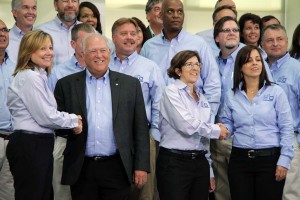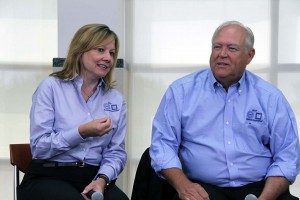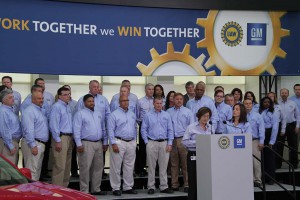
Handshakes and smiles mark the opening of GM-UAW contract talks. Shown in front: GM CEO Barra, UAW Pres. Williams, GM negotiator Clegg and UAW bargaining chief Estrada.
Compared to the last time they squared off four years ago, there was a very different mood in the air as negotiators from General Motors and the United Auto Workers shook hands and offered smiles for the cameras Monday morning, marking the start of their quadrennial contract talks.
As they sat down to hammer out a new contract in 2011, the memory of the devastating recession that drove GM into bankruptcy was still fresh. This time, the giant automaker is generating billions in profits and looking to grow even more. But the UAW clearly wants to get its share of that growth, especially for new GM employees who have been stuck in second-tier status that, noted union Pres. Dennis Williams, barely makes them qualify as middle-class.
In nearly identical blue shirts, Williams and GM CEO Mary Barra wore matching smiles and spoke repeatedly about working ”together” to find “creative solutions. But while he cautioned that a strike was not a goal but a sign of failure, Williams also declared “I’m not afraid of confrontation” during a media Q&A session.
As the largest of the domestic automakers, employing about 50,000 UAW members at its vast U.S. automotive operations, General Motors is the first of the Detroit Big Three to begin contract negotiations. Fiat Chrysler will begin talks tomorrow covering its American operations, and Ford Motor Co. will follow next week.
(For an in-depth look at the 2015 UAW-Big Three contract talks, Click Here.)
Each manufacturer negotiates individually but, if tradition holds, the UAW will eventually focus on one maker before the September 14th deadline to work out the deal it thinks will be best for its members. It will then push the other two companies to accept that as a “pattern” for their own agreements.
Despite the current similarities, there are a number of differences between the makers and due to other factors, all-in labor costs vary widely. GM is believed to be spending about $55 an hour for UAW labor, Ford $57 and Fiat Chrysler just $47, according to various industry analysts. That’s less than some of the so-called “transplants,” though many of the foreign-owned factories, such as the Hyundai facility in Georgia and various Toyota plants, have a labor cost advantage over the domestic Big Three.
That will weigh on both sides at GM, as well as Ford and FCA. The union, meanwhile, also has to consider the non-union operations as silent players at the bargaining table. The UAW has spent nearly three decades trying to organize the transplants, so far with little success. It recently won breakthrough representation rights at the new Volkswagen facility in Chattanooga, Tennessee and hopes to parlay that into victories elsewhere.
But observers caution that the union needs to prove it can win gains for its members — without resorting to confrontation and without limiting job growth in return for bigger wages and benefits.
“Together we are problem-solvers and that’s what it’s going to take,” declared Cathy Clegg, chief negotiator for GM, as the day’s events got underway.
For GM, clearly, a key goal is hold down any added expenses a new contract might contain. It is expected to press for further cost savings on health care and it has shown no interest in abandoning the two-tier wage system set up a decade ago in Detroit.
While UAW President Williams said he didn’t want to go into specifics, he did make it clear he wanted to target “stagnant wages,” and “address that gap” between the pay and benefits of first and second-tier GM workers. Williams has also suggested, in recent weeks, that the UAW may be able to help the automakers curb health care costs while also finding ways to boost productivity to offset any wage increases.
(Bigger is definitely safer when it comes to cars, new study reveals. Click Here for more.)
During her comments, GM CEO Mary Barra talked about the need for “transparency and respect,” and the desire to enhance job security while also satisfying shareholder needs.
Her tone was decidedly different from the words of past GM chief executives who were more blunt in putting earnings and margins at the top of their goals. Whether that reflects Barra’s individual approach or something more gender-based remains to be seen, but observers couldn’t help but notice that three of the four top-ranked players at the GM-UAW talks this year are women: Barra, Clegg and UAW chief negotiator Cindy Estrada.
But no one watching the contract talks begin would be advised to expect a love fest when the bargaining teams get down to business. There will be tough talk, sticking points and even threats. For the first time since GM was saved by a federal bailout, a clause barring a strike by the UAW has been lifted.
“I’m not afraid of confrontation,” Williams stressed, “but I don’t want one.” If anything, he emphasized, “a strike is a failure and one of the worst things you would do here.”
GM and the UAW now have a little over two months to prove they can do something better.
(Ferrari’s IPO is just “days away” from getting started. Click Here for more.)


